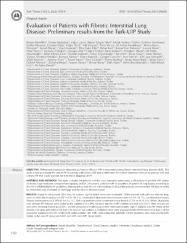Evaluation of Patients with Fibrotic Interstitial Lung Disease: Preliminary results from the Turk-UIP Study

View/
Date
2021Author
Müsellim, BenanMoğulkoç, Nesrin
Uzun, Oğuz
Tokgöz Akyıl, Fatma
Türktaş, Haluk
Özdemir Kumbasar, Özlem
Okumuş, Gülfer
Öğüş, Candan
Dirol, Hülya
Zamani, Adil
Sevim, Tülin
Annakkaya, Ali Nihat
Akıncı Özyürek, Berna
Hanta, İsmail
Aydemir, Yusuf
Çakır Edis, Ebru
Kurt, Bahar
Tertemiz, Kemal Can
Tabak, Levent
Yazıcı, Onur
Erdoğan, Yurdanur
Ateş, Güngör
Türker, Hatice
Salepci, Banu
Hazar, Armağan
Niksarlıoğlu, Elif Yelda
Yılmaz Kara, Bilge
Köktürk, Nurdan
Kalpaklıoğlu, Füsun
Uzel, Işıl
Özsu, Savaş
Atahan, Ersan
Fendoğlu, Türkan Zeynep
Yılmaz, Süreyya
Başyiğit, İlknur
Çamsarı, Güngör
Tuncay, Esin
Uçar Yılmazel, Elif
Kanmaz, Dilek
Ekici, Aydanur
Topçu, Füsun
Uzaslan, Esra
Bozkuş, Fulsen
Argun Barış, Serap
Duru, Serap
Altınışık, Göksel
Bingöl, Züleyha
Tunacı, Atadan
Savaş, Recep
Alper, Fatih
Bayraktaroğlu, Selen
Selçuk Can, Tuba
Demir, Ali Aslan
Metadata
Show full item recordAbstract
OBJECTIVE: Differential diagnosis of idiopathic pulmonary fibrosis (IPF) is important among fibrotic interstitial lung diseases (ILD). This
study aimed to evaluate the rate of IPF in patients with fibrotic ILD and to determine the clinical-laboratory features of patients with and
without IPF that would provide the differential diagnosis of IPF.
MATERIAL AND METHODS: The study included the patients with the usual interstitial pneumonia (UIP) pattern or possible UIP pattern
on thorax high-resolution computed tomography, and/or UIP pattern, probable UIP or possible UIP pattern at lung biopsy according to
the 2011 ATS/ERS/JRS/ALAT guidelines. Demographics and clinical and radiological data of the patients were recorded. All data recorded
by researchers was evaluated by radiology and the clinical decision board.
RESULTS: A total of 336 patients (253 men, 83 women, age 65.8±9.0 years) were evaluated. Of the patients with sufficient data for diagnosis (n=300), the diagnosis was IPF in 121 (40.3%), unclassified idiopathic interstitial pneumonia in 50 (16.7%), combined pulmonary
fibrosis and emphysema (CPFE) in 40 (13.3%), and lung involvement of connective tissue disease (CTD) in 16 (5.3%). When 29 patients
with definite IPF features were added to the patients with CPFE, the total number of IPF patients reached 150 (50%). Rate of male sex
(p<0.001), smoking history (p<0.001), and the presence of clubbing (p=0.001) were significantly high in patients with IPF. None of the
women <50 years and none of the men <50 years of age without a smoking history were diagnosed with IPF. Presence of at least 1 of the
symptoms suggestive of CTD, erythrocyte sedimentation rate (ESR), and antinuclear antibody (FANA) positivity rates were significantly
higher in the non-IPF group (p<0.001, p=0.029, p=0.009, respectively).
CONCLUSION: The rate of IPF among patients with fibrotic ILD was 50%. In the differential diagnosis of IPF, sex, smoking habits, and the
presence of clubbing are important. The presence of symptoms related to CTD, ESR elevation, and FANA positivity reduce the likelihood of
IPF.
Volume
22Issue
2Collections
The following license files are associated with this item:

















